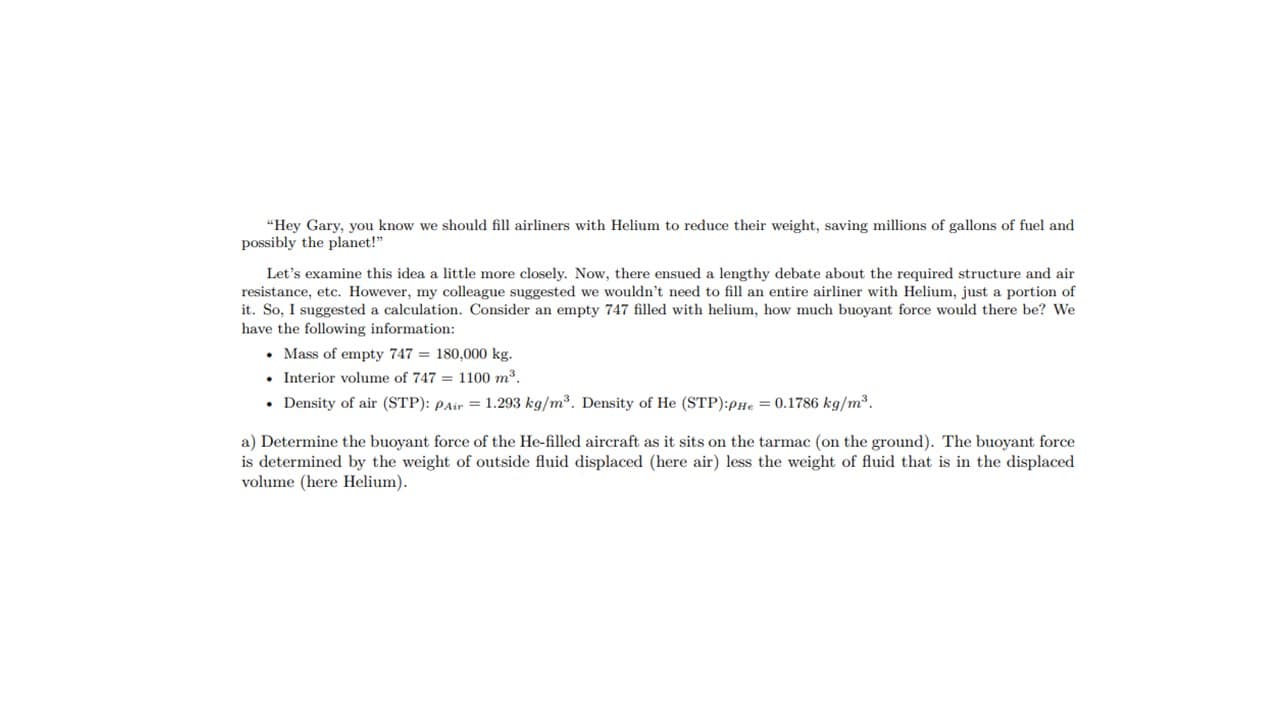"Hey Gary, you know we should fill airliners with Helium to reduce their weight, saving millions of gallons of fuel and possibly the planet!" Let's examine this idea a little more closely. Now, there ensued a lengthy debate about the required structure and air resistance, etc. However, my colleague suggested we wouldn't need to fill an entire airliner with Helium, just a portion of it. So, I suggested a calculation. Consider an empty 747 filled with helium, how much buoyant force would there be? We have the following information: • Mass of empty 747 = 180,000 kg. • Interior volume of 747 = 1100 m3. • Density of air (STP): PAir = 1.293 kg/m3. Density of He (STP):PHe = 0.1786 kg/m³. a) Determine the buoyant force of the He-filled aircraft as it sits on the tarmac (on the ground). The buoyant force is determined by the weight of outside fluid displaced (here air) less the weight of fluid that is in the displaced volume (here Helium).
"Hey Gary, you know we should fill airliners with Helium to reduce their weight, saving millions of gallons of fuel and possibly the planet!" Let's examine this idea a little more closely. Now, there ensued a lengthy debate about the required structure and air resistance, etc. However, my colleague suggested we wouldn't need to fill an entire airliner with Helium, just a portion of it. So, I suggested a calculation. Consider an empty 747 filled with helium, how much buoyant force would there be? We have the following information: • Mass of empty 747 = 180,000 kg. • Interior volume of 747 = 1100 m3. • Density of air (STP): PAir = 1.293 kg/m3. Density of He (STP):PHe = 0.1786 kg/m³. a) Determine the buoyant force of the He-filled aircraft as it sits on the tarmac (on the ground). The buoyant force is determined by the weight of outside fluid displaced (here air) less the weight of fluid that is in the displaced volume (here Helium).
Related questions
Question

Transcribed Image Text:"Hey Gary, you know we should fill airliners with Helium to reduce their weight, saving millions of gallons of fuel and
possibly the planet!"
Let's examine this idea a little more closely. Now, there ensued a lengthy debate about the required structure and air
resistance, etc. However, my colleague suggested we wouldn't need to fill an entire airliner with Helium, just a portion of
it. So, I suggested a calculation. Consider an empty 747 filled with helium, how much buoyant force would there be? We
have the following information:
• Mass of empty 747 = 180,000 kg.
• Interior volume of 747 = 1100 m3.
• Density of air (STP): PAir = 1.293 kg/m3. Density of He (STP):PHe = 0.1786 kg/m³.
a) Determine the buoyant force of the He-filled aircraft as it sits on the tarmac (on the ground). The buoyant force
is determined by the weight of outside fluid displaced (here air) less the weight of fluid that is in the displaced
volume (here Helium).
Expert Solution
This question has been solved!
Explore an expertly crafted, step-by-step solution for a thorough understanding of key concepts.
This is a popular solution!
Trending now
This is a popular solution!
Step by step
Solved in 2 steps
